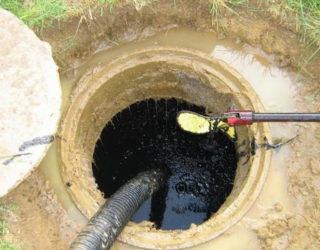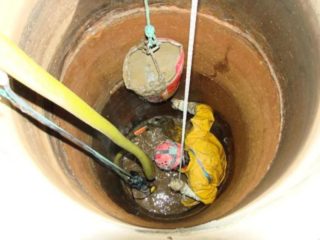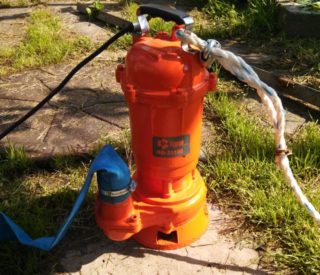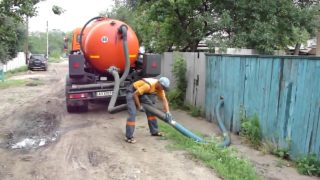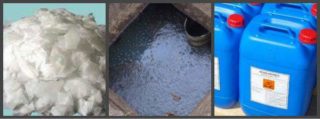Each owner of a summer cottage or country house is faced with the problem of arranging and maintaining an autonomous sewage system. A properly constructed sewage pit may not require special attention for several years. But over time, many owners begin to notice the appearance of a strong unpleasant odor or overflow of the container. Any kind of sewage system, whether it is a sealed septic tank or a small cesspool, requires proper maintenance. Timely, regular cleaning protects against a range of potential problems. There are several ways to pump out sewage. Let's consider their advantages, disadvantages and choose the best one.
What is the reason for the need for pumping
If you do not pump out the waste in time, there is a risk of disruption of the functioning of the drainage system. Silting of the bottom gradually occurs, which in turn leads to:
- overflow of the reservoir;
- the appearance of an unpleasant odor in the surrounding area;
- the inability of the drainage system to cope with its functions.
Pumpdown methods
With your own hands
Pumping can be done by hand, provided that the size of the cesspool is small. The procedure is not pleasant: a minimum of comfort for the owners of the house, unpleasant odors throughout the site. But often, this is one of the few methods that are available in villages or dachas remote from the center, where there is no way to call specialists or the call will be quite expensive. And it is also unprofitable to order a tank for pumping a small volume.
An independent pumping procedure can be carried out in two ways:
- Manually
- Using a pump
Without pump
The only advantage of manual pumping is the financial component, or rather its absence.
With pump
It is recommended to use a specialized fecal pump, which differs from the usual one with increased productivity, quality and built-in filter. Some models are also equipped with a blade for crushing large particles, which allows crushing large fractions of waste, not clogging equipment and serve a longer service life.
It is possible to pump out with a conventional water pump, but with their help only liquid can be pumped out. Heavy fractions of faeces will remain in the pit. To get rid of them, after a while you will still have to turn to a bucket of rope. The container with the drained sewage is also taken to a place designated by the local authorities for disposal.For a conventional pump, the installation of additional filters is mandatory, without which the equipment will quickly fail.
Independent pumping methods are possible provided that a small number of people live temporarily, otherwise the removal of the pumped out masses will have to be carried out several times a month or even a week. A way out of this situation will be a separate large tank where you can store sewage, and, after accumulating a sufficient volume, dispose of it using a sewage machine.
Waste disposal machine
The advantages and attractiveness of this method are:
- comfort, minimal waste of time;
- no need to carry out a complex of time-consuming, unpleasant work;
- the order of the car is carried out by means of a phone call, and the order of special equipment at a time convenient for you.
It remains only to meet the car and control the process: the waste must be removed completely, without residues. Incomplete pumping of the pit can cause further silting of the bottom.
Among the shortcomings, the following points can be highlighted:
- the cost of sewer services is quite high;
- The septic tank should be located as close as possible to the fence, for convenient access for equipment, and so that the suction hose can reach the bottom of the pit. In the absence of conditions, the procedure will not be possible.
Biological substances
Benefits:
- Ease of use: the drug is poured directly into the toilet, flushed. Also, the product diluted with water can be applied directly to the pit.
- Manufacturers offer various preparations designed for different types of septic tanks: an autonomous toilet, a cesspool or compost. Information is indicated on the packaging.
- Safety for humans, nature.
- No need to worry about waste disposal.
The effectiveness of microorganisms is achieved with regular use, according to the recommended schedule in the instructions. However, keep in mind that their action is suppressed by harsh chemicals, which could be counted among the minuses. But by limiting the flow of household cleaning agents into the waste system on the day of pumping, you give bacteria complete freedom of action.
Conclusion
It's hard enough to say which method is better. Each of them has its own pros and cons. It would be more correct to say about the pumping method suitable for you. You need to proceed from the individual situation: the territorial position of the site, the possibility of calling specialists, the volume, type of septic tank.
If speed and comfort are important, the best option is the services of specialized equipment. In conditions of impossibility to call a sewer, biological products will provide efficiency and speed.
If the cost of services matters, the only option is the manual method. But there can be no talk of any convenience and speed. The rest of the methods cannot be called economical, they are about the same in terms of costs.
It is worth noting that the best solution for many owners is to combine several methods. For example, in a suburban remote area, treatment with biological preparations is combined with pumping out by a pump. And residents of the central regions use septic drugs to reduce the number of calls to the services of a sewer truck.

